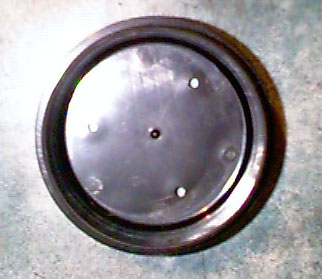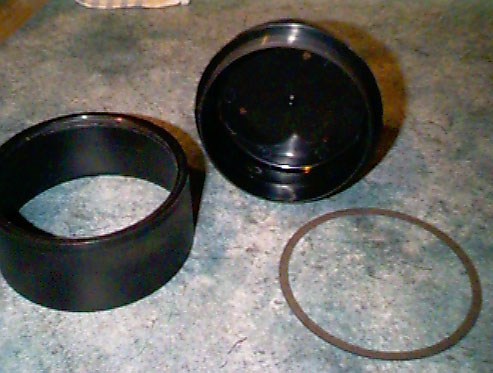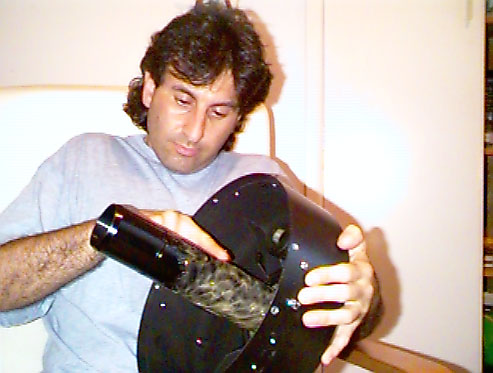
New C11 Problems
I recently acquired a new C11 OTA. From the first night out, it would not hold collimation. I did a lengthy collimation as accurately as possible using a very good technique as outlined by Thierry Legault . Then accurately focused on the star using a hartmann mask. The star images looked fantastic. Then I swung the scope over the celestial equator and the meridian around to Jupiter. It was out of focus. Defocusing further showed an obvious off-center secondary shadow. I moved to a nearby star and checked collimation. It was way off. I re-collimated. Swung to Jupiter. It looked great. Swung over the meridian to Saturn. It was slightly out of focus. Checking on a nearby star showed collimation was off again. What was going on?

The C11 OTA ready for disassembly
Scouring the internet for information, I found a host of others that had had similar problems. I knew about mirror flop but had not experienced it with my old C8 and hadnít realised how prevalent it was. Apart from the standard mirror flop most people with SCTs were experiencing, a few had also experienced similar collimation issues to mine. At least two that I found had been the result of the primary mirror coming loose from its mount and flopping slightly. These were both repaired by returning to Celestron. One of these repairs had the problem recur 12 months later and so the owner successfully initiated a self-repair by using RTV (silicon) to fill the gap between the primary and focus arm which is attached to the primary mirror mount.
I found a very good thread on the problem in the Mapug archive , It seems a lot of people are having problems with mirror flop. In the archive I found a thread about a loose secondary holder causing collimation shifts, and it outlined steps to check if the secondary holder was loose. It involved simply trying to turn it by hand and without forcing it. I tried this and the whole secondary holder turned easily. It could also move laterally from side to side and up and down by more than a millimeter in any direction. It did not seem loose enough to fall under itís own weight though so I was skeptical about this being the cause of my collimation problems. Still it needed to be repaired.
A call to Celestron told me that the scope should be returned to my supplier Bintel in Sydney. Don Whiteman of Bintel was on holidays for a couple of weeks but returned eager to fix my problem with the minimum of fuss. He gave me instructions for attempting to tighten the secondary cell by removing the corrector plate and attempting to tighten the baffle from the inside. I tried this but it was just way too tight. Some on the Celestron mailing list say that Celestron glues their secondary holders together and so they cannot be adjusted. Iím not sure about this. Don then arranged for Celestron to send me over a new secondary mirror cell and gave me instructions on how to install it.
In preparation for this, I disassembled the C11 OTA and took the opportunity to check out how everything works, stripping it entirely.

Corrector off and Secondary Mirror removed

The inside of the secondary cell.
The 3 holes for the alignment screws can be seen as well as the pivot in the centre that goes into a hole in the center of the secondary mirror mounting plate. The metal secondary mirror mounting plate (not shown) has lines drawn from the pivot hole to one side of the secondary. These should point toward the engraved number in the front-side of the edge of the corrector plate. The corrector serial should line up with the 3-o'clock corrector retaining ring screw hole.

The secondary cell baffle and washer(s?)
The secondary cell and baffle screw together with the corrector plate between them. The outside washer is is shown, where was the inside one? The new secondary cell from Celestron had two washers.

Rear Cell with Tube removed
After removing the primary mirror, I held it firmly around the focuser tube in front of the mirror and the held the focuser arm behind the mirror in the other hand. Moving the whole gizmo from side to side, gave an audible Ďclunkí. Huh! I could actually feel the focuser sleeve moving from side to side in the center of the primary mirror. It was looser than the secondary cell was. Things have to get better soon donít they?

The C11 primary mirror in its cell with focus arm to the right.
The red stuff is the cement used to bond the primary to the cell. It is very unevenly distributed but I am not sure if this matters.
I placed the mirror face up on a wooden block to see if the primary was loose in its cell. Holding the primary firmly down by the focuser sleeve, I attempted to pull the primary up from underneath while carefully watching the join between the mirror and cell. It was lifting very slightly on whatever side I lifted. I am not sure just how tight the primary is supposed to be on its cell, but it looked loose to me. I decide to leave this for now and think about whether to send it back to the U.S. (required for this job), or take to the focus arm and primary with a tube of silicon to try and fix it as others have.

The focus sleeve and collar on the face of the primary. The collar was loose and the sleeve moved from side to side.
There is a large round collar around the focuser sleeve in front of the primary that has a hole on either side that looks like they might be for some special o-ring clip type of pliers for tightening the lug onto the primary. I attempted to turn this with my fingers and sure enough it spun easily. I tightened it hand tight, then a tiny bit more not knowing if I could warp the primary by tightening it too tight, I was very careful.
Then I tested it again by slowly swinging the primary assembly as before. The clunk was gone and there was no noticeable movement of the focuser sleeve. I then retested lifting the primary from the cell as before. It now only moved very slightly. Barely noticeable even. I decided that before doing anything else, I would reassemble the scope with the new secondary holder and see how it behaves.

Results
The results are positive. The scope now holds collimation but still occasionally shifts focus slightly after slewing. I attribute this to the primary moving. It also has significant image shift when changing focus direction. Finally it has some coma and astigmatism around the edge of the field.
Image Quality
It also provides astounding images in the center of the field. With any eyepiece, There was only a sweet spot of about half a degree right in the center. Anything further showed coma and astigmatism worsening to the edge and radiating apparently from the center.
I've had an eyetest recently and knew it wasn't me, and I had eliminated eyepieces by the rotation test. Finally recording it onto ccd told me that it was the scope.
I guess it could have been expected given that the scope had been dismantled more than once and had more than one loose optical element for who know how long. I finally decided to send it back. 11 months after receiving it.
Primary Mirror Alignment
Being one of the only things I didn't look for previously, I thought I should at least check it. Using the line of sight approach from Suiters Star Testing, From a position where the secondary holder is slightly smaller and centered within the reflection of itself in the primary, look for an asymmetry. It looked pretty good to me.
Alchemy?
Finally, in an attempt to minimise image shift, I used a heavy-duty high-temperature grease to lube the primary/focus shaft. I used a lot. Then I was told that when left in the sun, this stuff can give off an emission that winds up on your inside glass surfaces. So... I told by a very helpful fellow, that a concoction of Vaseline and Violin Bow Resin (that's one standard resin cube to one small jar of Vaseline), created a thick lube with very low emission. I thought it was getting a bit too alchemic for me, but tried it anyway. The mixture has to be heated over a low heat for a while. The Vaseline had a disturbingly low melting point but the resin took forever to even go soft let alone melt, so I thought the combination might actually work well. I ended up with a pleasing orange goo and coated it liberally over the shaft.
Ok I know that looks like way too much lube, but the idea was, to try and get as much grease into the primary tube as possible. I put the primary back on and gave is some slides to distrubute the lube. Then removed the primary and cleaned out the excess which was sitting in the bottom of the cell. Then replaced the primary.
This was actually only the second try.
A few people had been using Dow Corning High-Vacuum Grease, a clear grease that resisted being squeezed-out under pressure, so after testing the above concoction and finding it made little difference, I managed to locate some High-Vacuum grease at the local Bearing Service depot. The long-term employee was most surprised that she had never heard of it before yet they had it in stock, so it must be rarely asked for. The box was in good condition but covered in the type of dust that has crusted into the cardboard over time.
This stuff worked very well and actually had a positive effect on focus slop, making focusing feel a lot stiffer and less sloppy. Mirror flop however, was still a problem.
Back To Celestron
I had been dreading having to send it back across the Pacific, but felt there were no other options. It was now or never.
The scope was gone for 3 months (which ibncluded one month of confusion where nothing happened but phone calls) and Celestron did a pretty good job with it once they did get it.
The focus shift and mirror flop (not my major concern, behind the optical quality), were acknowledged to be excessive and they did a great job on it, I am told by replacing the primary cell baffle that holds the primary mirror.
They also apparently replaced the secondary and realigned everything. I must say that things do look a whole lot better. But I believe there is still an issue with mirror flop. When looking at objects low on the horizon, the familiar seagull-shaped stars start to appear even very close in to the center of the field. Possibly even a little worse than before, but only as the tube gets closer to horizontal.
Conclusion
I'm pretty happy with the scope in general. I believe the remaining issues I have with it are entirely normal for this type of telescope and many people have implemented inventive solutions to these problems.
For details on disassembling a C11 take at Phil Laughtons page C11 Disassembly
See Chris Heapy's page for excellent methods and attempts at removing mirror flop
Roth Ritter's very nice C11 mods page has more solutions for dealing with various SCT issues including mirror flop.